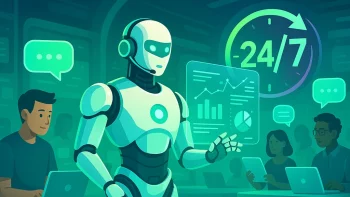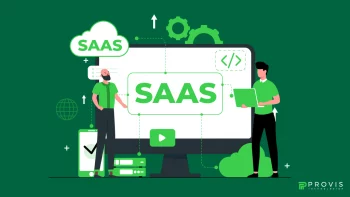By the year 2024, the world’s e-learning market share is expected to stand at about $ 400 billion from current statistics, and this growth is a result of the enhanced use of ICT in education sectors as well as corporate entities. It is a continuation of the overall tendency to grow the use of online education and the need for open, flexible, and scalable educational applications globally.
The transfer to the sphere of online education has opened a sea of opportunities for entrepreneurs. It is the best of times to turn the screw and come up with the best eLearning software while at the same time ensuring that business revenue increases.
However, since it results in the development of software products, planning, development, and testing are required since the software only develops in a day. The time needed to build may be reduced if the developers follow the proper procedures during the process.
The following guide outlines the processes that assist in starting the development of the eLearning software.
Understanding E-Learning Software
E-learning software development applications are programs that are designed to help users study and access various educational materials via the web, interactive courses, Video/audio tutorials, quizzes, and forums.
It can vary from only the learning management system and go up to LMS with features such as virtual classroom, gamification, and analytics. Software solutions company for e-learning aids in flexible delivery, interaction, and availability of education for the improvement of learning.
Also Read: Custom Education App Development: Cost & Features
Step1: Establish Your Goals And Plans
The first step in your E-learning portal project is what you want to achieve. Consider the following questions:
- What kind of e-learning platform are you developing? e.g., could refer to an LMS, a MOOC, or a corporate training platform.
- Who do you want to teach your content to? Some samples include students, professionals, employees, and even pupils.
- What particular needs or issues will your software satisfy?
- Which characteristics can your platform have? And here—content management, the tools for interactive learning, testing and assessing, and statistical analysis tools.
Defining the vision and scope of development will help steer the whole process and enable software that will fit the needs of the users.
Step 2: Market research
In this step, the organization must carry out a market analysis to know its competitors, target customers, market needs, and specifics of operating in the market.
Formative data collection is essential in assessing the environment of e-learning software development and viable prospects and threats. When the topic is e-learning, consider modern tendencies, which are mobile learning, microlearning, and AI-based personalized learning. Make yourself familiar with their business models, the type of talent they have, advanced or basic services, and how to possibly add a new dimension to your service.
Get the experiences of potential consumers to identify their concerns and demands. This research will assist you in refining your idea and creating an invention that will make your target market resonate.
Related Blog: Cloud-Based Application Development: A Step-by-Step Guide
Step 3: Right Technology For The Business
The choice of the technology stack is a crucial factor in developing a stable platform for the e-learning portal project. The technologies that you select will be the determinants of how the platform will perform, how secure it is, or how it will respond to the users. Consider the following components:
- Front-End Development: The front-end is the part of the software that the user can interact with. Development tools such as HTML, CSS, JavaScript, or any of the frameworks like react, angular, vue, etc..… js are used in the development of engaging and more striking front-end designs most of the time.
- Back-End Development: The back-end focuses on the business logic issues, data management, and users’ authentication procedures on the server side. Back-end technologies include Node—xs, ASP.NET, JavaScript, Django, Ruby on Rails, and Java. A good relational database or a NoSQL database, such as MySQL, PostgreSQL, MongoDB, etc., is also required.
- Content Management: An e-learning platform needs a robust content management system to produce, sort, and disseminate educational material. One is to develop a new CMS, and the other is to use an existing one, although the latter is limited to options like WordPress or Drupal.
- APIs and Integrations: Adduing third-party API payments, video conferencing analytics, or any other type of analytics can significantly improve the functionality of your platform. For example, Zoom’s API can support the provision of live virtual classes, and Stripe’s API can support payment functions.
- Cloud Services: Web hosting facilities like AWS, Google Cloud, or Azure will provide you with the perfect environment that we need to host an e-learning platform to handle significant traffic and big data volume.
Making the right decisions when it comes to the technology stack that will underlie your e-learning software development system will not only make the platform capable of supporting large numbers of concurrent users. But also provide adequate levels of security and user experience that will make the difference between a good and a great learning experience.
Step 4: Designing the User Experience (UE) User Interface (UI)
To a greater extent, the aesthetic outlook of your E-learning portal project has a significant influence on learners’ experiences. The significance of UI/UX can again be measured by the fact that learning with a good UI/UX is more fun-filled and practical than with a bad one. Here’s what to consider:
- User-Centered Design: This means that the most important thing is the ability to facilitate the users’ use of the web application. User research is to identify and incorporate into its design aspects the behavior of the target audience when interacting with digital learning tools.
- Consistent Design Elements: To make it unified, use similar colors, fonts, and layouts throughout the company’s platform. This not only makes the platform look professional but also makes it easy to navigate through the different sections.
- Responsive Design: The way users will be accessing your platform will be across devices and hence should be responsive – should work equally well on desktops, tablets, and mobiles.
- Intuitive Navigation: One must ensure they use a logical approach when arranging their content and ensure that they use the correct labels and menus for ease of navigation. It should be easy for users to access the intended content.
- Interactive Elements: Use a quota of questions, discussion boards, would you rather, and other forms of interaction to boost learning. Interactive features can enhance the usual learning process and make it much more engaging and thirst-quenching.
For wireframing and creating final mockups of your E-learning software development platform design, you can use any online tool for AI like Figma, Sketch, or Adobe XD. When these prototypes are made available to real users, further information can be obtained, and one can work on the design for actual development.
Don’t Miss: A Step-by-Step Guide for FinTech App Design With Expert Tips
Step 5: Defining its Purpose
The next step is thus to build the fundamental functionalities of an e-learning platform. You’ll incorporate these as core components of your software solutions company to enable users to learn effectively. Key features to consider include:
- Course Management: Permit instructors to design courses, post content, and organize them in a manner that includes a course or lessons and modules. Accommodate a range of content delivery media, such as full text, video, audio, and PDFs.
- User Management: Admin / Moderator / Power users / Normal users / Guests, etc., with variations in user rights and authorization. Offer learners an account to enable them to monitor their performance and accomplishments.
- Assessment and Quizzes: Provide features for generating quizzes, tests, and assignments for students. Integrate features such as auto grading and auto-generating feedback to help instructors save time and give results to the learners as soon as possible.
- Discussion Forums: Enable learner and instructor communication through the use of bulletin boards or conferences. This fosters teamwork and group affairs among the students, as well as one-on-one learning.
- Analytics and Reporting: Given sufficient data analysis, reliable information on learners’ performance and course completion rates, as well as many other various engagement statistics. As for the teachers and administrators, it will help to enhance the learning-teaching process and evaluate the efficiency of the platform.
- Payment Gateway Integration: If it is a paid platform, include a payment gateway, which will ensure the security of transactions if your platform includes paid courses. Some of the most well-known examples are Stripe, PayPal, and Square.
- Mobile Compatibility: This suggests furthering your business by mobile application development or ensuring that your business platform is conducive to mobile utilization. It is essential to optimize for mobiles because most learners get their content through their mobile devices.
Creating these core features involves coordination between front-end and back-end engineers, designers, and quality assurance analysts. To avoid this, the development team can use continual reporting and communication as well as project management tools, such as Jira or Trello.
Step 6: Admission to Security and Compliance
The issues of security remain the most crucial concerning e-learning software development since they are mainly concerned with personal data processing, payment information, and the contents of educational materials. Implement the following security measures:
- Data Encryption: Encryption technologies such as SSL/TLS should be employed to secure data as it is both in transit and storage. Make sure that the passwords created by the users, as well as any other payment details entered, are well stored and encrypted.
- User Authentication: One crucial policy that should be applied is to enable multi-factor authentication (MFA). Passwords, fingerprints, and one-time pins are some forms of secure authentications that are normally used to gain access.
- Data Privacy Compliance: Make sure that your platform meets the requirements of the data protection legislation, such as GDPR in the European Union or FERPA in the USA. Be transparent in the procedures used and statements made about protecting user information, and always seek permission from the users for the collection of their information.
- Regular Security Audits: The following are the best practices to follow: The company must conduct a security audit and vulnerability assessment to ensure they recognize areas of risk to their networks, systems, and data. Be informed at regular intervals of the new security threats and the recommended measures to avoid them.
Security and compliance are not one-and-done processes but rather are considered throughout the life of the e-learning platform. Schedules for updates and review processes are particularly crucial to prevent your platform from becoming a security vulnerability and to ensure that the platform is conformant with the current laws and policies.
Step 7: Testing
This stage of e-learning software development is testing, as it helps to determine all possible issues and possible risks and whether the service is secure and meets users’ expectations. Some of the essential steps that can be followed to test an e-learning software development services platform include the following:
- Unit Testing: Check out the capability of each part of your integrated platform to work efficiently. This assists in pointing out errors that require correction in an early stage to avoid extending problems to other phases of development.
- Integration Testing: The verification of the integration of various components and other third-party services.
- Security Testing: Conduct network penetration testing and vulnerability assessment to determine the various existing security weaknesses.
- User Acceptance Testing (UAT): Recruit actual users of the platform for feedback on the area of functionality, usability, and feel of the platform. UAT is crucial since it exposes additional problems that may have yet to be realized when the software is under internal testers.
- Performance Testing: Stress the system and demand for it, including intense loads, an abundance of data, active user interaction, and noteworthy performance deterioration.
Testing must be done at intervals throughout the developmental stage, and feedback must be implemented instantly in case of a problem. The testing phase proves that your platform is stable, sound, and ready to be released to the public.
Step 8: Promote Your E-Learning Platform
Towards the end of the development of the e-learning platform, the most crucial step comes, and that is the launch of the interface that has been developed and tested. The problem with such a move is, therefore, not its feasibility but the fact that it entails a setup that needs to be done well. Here’s what to consider:
- Pre-Launch Marketing: Looking at social, scholars should begin creating hype about the existence of the platform before it is even launched. Create awareness of the diamond through word of mouth, social media, e-mail marketing, and content marketing.
- App Store Submission: If you have created a mobile application, it should be sold in various application stores, including the Apple App Store and Google Play Store, among others. Make sure the app meets all the guidelines and requirements of the platforms of your choice.
- Launch Event: It might be a good idea to stage a launch to announce your presence to the public through an online occasion. This can be done in the form of a live demonstration, a question and answer session, or an early bird discount.
- Post-Launch Support: After that, the authors of the software should continue helping the users solve problems and answer their questions, as well as gathering stakeholders’ suggestions for subsequent updates. It is necessary to update your platform from time to time to eliminate all the bugs, add new features, and even enhance the security of the platform.
- Monitor Performance: The tracking of users’ behavior, course completion rates, and other parameters should be conducted using analytics tools. The necessary data is given below; with its help, you will be able to determine all the deficiencies and, if required, create improvements to increase the efficiency of your platform.
Must Know: How to Create an App Using AI/ML for Your Business
Conclusion
The opportunity in the e-learning market is very vast, so new entrepreneurs can start up a business to transform the existing education sector drastically. In general, there might be several challenges in constructing an innovative eLearning app. However, having hired appropriate information technology specialists will help you get a good eLearning app up and running.
As most organizations seek to be involved in this digital transformation, businesses can benefit from custom eLearning solutions with many advantages. If you need help designing the kind of eLearning software you want, kindly contact us. Provis Technologies is the leading eLearning app development agency.
Having worked for many years in the software development arena, our specialists will help organizations navigate challenges. Contact us now for a consultation and develop the future of eLearning software.
Written By
Author's Picks
- No-Code and Low-Code Platforms: Revolutionizing Mobile App Development in 2024
- 13/09/2024
- How To Build A Minimal Viable Product (MVP) And Raise Funding In 2025?
- 28/10/2024
- Custom Education App Development: Cost & Features
- 31/08/2024
Categories
- AI for Startups
- AI in Web Development
- AI Integration
- AI Platforms
- AI Prompt
- AI Tools
- AI Trading Software
- Android App
- Android vs iOS Development
- Angular
- API
- API Development
- App
- app development
- App Idea
- App User Feedback
- Application
- Artificial Intelligence
- Audit Services
- Automotive Industry
- Awards and Recognition
- Business Consulting
- Business Website
- Chatbots
- CRM
- CRM for Financial Advisors
- Custom CRM
- Custom SaaS
- Custom Website
- Customer Service
- dashboard design
- Developing a Mobile App
- Digital Business
- E-commerce
- EMR Integration
- Finance
- Financial Advisors
- Financial Advisors
- GIT
- Health Insurance
- iOS App
- iOS App Development
- IoT Mobile App Development
- IoT Platforms
- IT Audit Services
- IT Consulting
- IT Strategies
- Java Development
- Laravel
- Lean Canvas
- Learning Management System
- Logistics Apps
- Mobile App Development
- MVP
- Native App
- News Aggregator Site
- OTT
- Outsourcing IT
- Payment Gateway
- predictive analysis
- Product Launch Strategy
- Progressive Web App (PWA)
- Prototype
- Recommender Systems
- Ruby
- SaaS
- SaaS Application
- SaaS Business
- SaaS Company
- SaaS Development
- SaaS Product
- SaaS Project
- Sales Funnel
- SEO
- Shopping Cart
- Software Development
- SSL and TLS
- Startup Checklist
- Technology
- Tetradic Color Scheme
- UI/UX Design Company
- Unit Testing
- User Flow
- User Testing
- Web Development
- Web Performance Optimization
- website Maintenance Services
- Website Migration Service
- Website Speed Optimization
- WooCommerce
- WordPress





